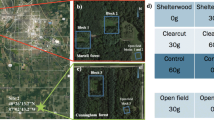Abstract
Grand Fir Mosaic forests innorthern Idaho are difficult to regenerate afternatural or human-caused disturbances. Sparseconifer regeneration appears to be associated withhigh populations of northern pocket gophers (Thomomys talpoides) plus expansion by bracken fern(Pteridium aquilinum (L.) Kuhn) and invasionof western coneflower (Rudbeckia occidentalisNutt.). This report updates an earlier study(Ferguson and Adams 1994) that quantified theeffects of four treatments on survival and growth ofplanted conifers: unweeded with gophers, weeded withgophers, unweeded without gophers, and weededwithout gophers. Weeding removed only bracken fernand western coneflower. Subalpine fir (Abieslasiocarpa (Hook.) Nutt.), grand fir (Abiesgrandis (Dougl.) Lindl.), and western larch (Larix occidentalis Nutt.) had over 80% mortalityfrom pocket gophers and other causes. Lodgepolepine (Pinus contorta var. latifoliaEngelm.) had 49.2% mortality from pocket gophersand 6.8% mortality from other causes, but snowdamage is a problem for lodgepole pine. Engelmannspruce (Picea engelmannii Parry ex Engelm.)had 42.2% gopher-caused mortality and 8.4%mortality from other causes. Spruce suffered littletop damage from snowpacks and was stout enough towithstand senescing bracken fern fronds. Westernwhite pine (Pinus monticola Dougl.) had only24.1% mortality from pocket gophers after 4 years,and only 11.8% of the white pine died from causesother than gophers. Of the mortality caused bypocket gophers, 76.8% occurred the first summer andnext two winters after planting. The recommendedspecies for reforestation are Engelmann spruce andwhite pine.
Similar content being viewed by others
References
Cooper, S.V., Neiman, K.E. and Roberts, D.W. 1991. Forest habitat types of northern Idaho: a second approximation. USDA Forest Serv., Intermountain Research Sta., Ogden, Utah. Gen. Tech. Rep. INT-236. 143 p.
Chase, J.D., Howard, W.E. and Roseberry, J.T. 1982. Pocket gophers, pp. 239–255. In: Chapman, J.A. and Feldhamer, G.A. (Eds.) Wild Mammals of North America: Biology, Management, and Economics. John Hopkins Univ. Press, Baltimore, Maryland.
Crouch, G.L. 1971. Susceptibility of ponderosa, Jeffrey, and lodgepole pine to pocket gophers. Northwest Science 45: 252–256.
Crouch, G.L. 1979. Atrazine improves survival and growth of ponderosa pine threatened by vegetative competition and pocket gophers. For. Sci. 25: 99–111.
Ferguson, D.E. 1991. Allelopathic potential of western coneflower (Rudbeckia occidentalis). Can. J. Bot. 69: 2806–2808.
Ferguson, D.E. and Adams, D.L. 1994. Effects of pocket gophers, bracken fern, and western coneflower on survival and growth of planted conifers. Northwest Science 68: 241–249.
Ferguson, D.E. and Johnson, F.D. 1996. Classification of Grand Fir Mosaic habitats. USDA Forest Serv., Intermountain Research Sta., Ogden, Utah. Gen. Tech. Rep. INT-337. 16 p.
Gliessman, S.R. 1976. Allelopathy in a broad spectrum of environments as illustrated by bracken. Linn. Soc. Bot. J. 73: 95–104.
Keith, J.O., Hansen, R.M. and Ward, A.L. 1959. Effect of 2,4–D on abundance and foods of pocket gophers. J. Wildl. Mgmt. 23: 137–145.
Kirk, R.E. 1982. Experimental Design: Procedures for the Behavioral Sciences, 2nd ed. Brooks/Cole Pub. Co., Belmont, CA. 911 p.
Marsh, R.E. and Steele, R.W. 1992. Chapter 10 - Pocket gophers, pp. 205–230. In: Black, H.C. (tech. Ed.) Silvicultural Approaches to Animal Damage Management in Pacific Northwest Forests. USDA Forest Serv., Pacific Northwest Research Sta., Portland, Oregon. Gen. Tech. Rep. PNW-287.
Muller, C.H. 1969. Allelopathy as a factor in ecological process. Vegetatio 18: 348–357.
Okello, M.M. 1993. Pocket gopher (Thomomys talpoides) food preferences, habitat relationships, and damage prevention. M. S. thesis. University of Idaho, Moscow. 64 p.
Rehfeldt, G.E. 1994. Evolutionary genetics, the biological species, and the ecology of the interior cedar-hemlock forests, pp. 91–100. In: Baumgartner, D.M., Lotan, J.E. and Tonn, J.R. (Eds.) Interior Cedar-Hemlock-White Pine Forests: Ecology and Management. Washington State Univ. Pullman.
Rice, E.L. 1984. Allelopathy, 2nd ed. Academic Press, Inc. Orlando, Florida. 422 p.
SAS. 1985. SAS/STAT guide for personal computers. Version 6. SAS Institute Inc., Cary, North Carolina. 378 p.
Steel, R.G.D. and Torrie, J.H. 1960. Principles and Procedures of Statistics. McGraw-Hill Co. New York. 481 p.
Stewart, R.E. 1975. Allelopathic potential of western bracken. J. Chem. Ecol. 1: 161–169.
Teipner, C.L., Garton, E.O. and Nelson, L. Jr. 1983. Pocket gophers in forest ecosystems. USDA Forest Serv., Intermountain Forest and Range Exp. Sta., Ogden, Utah. Gen. Tech. Rep. INT-154. 53 p.
Tietjen, H.P., Halvorson, C.H., Legdal, P.L. and Johnson, A.M. 1967. 2,4–D herbicide, vegetation, and pocket gopher relationships, Black Mesa, Colorado. Ecology. 48: 634–643.
Turner, G.T., Hansen, R.M., Reid, V.H., Tietjen, H.P. and Ward, A.L. 1973. Pocket gophers and Colorado mountain rangeland. Colorado State Univ. Exp. Sta., Ft. Collins. Bulletin 554–S. 90 p.
Znerold, R.M. 1979. Western bracken control with asulam. M.S. thesis. Washington State University, Pullman. 36 p.
Author information
Authors and Affiliations
Rights and permissions
About this article
Cite this article
Ferguson, D.E. Effects of pocket gophers, bracken fern, and western coneflower on planted conifers in northern Idaho – an update and two more species. New Forests 18, 199–217 (1999). https://doi.org/10.1023/A:1006504700542
Issue Date:
DOI: https://doi.org/10.1023/A:1006504700542




